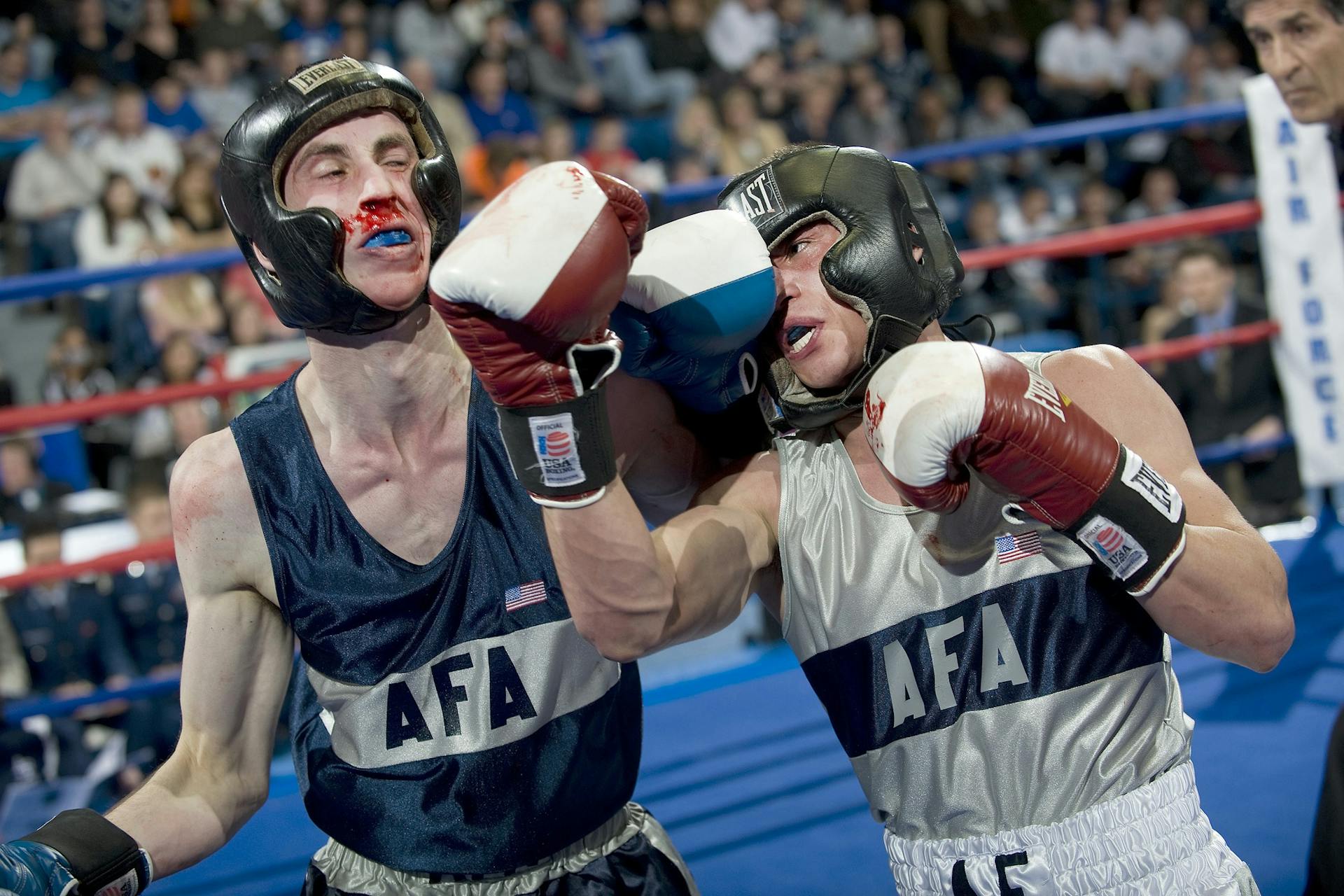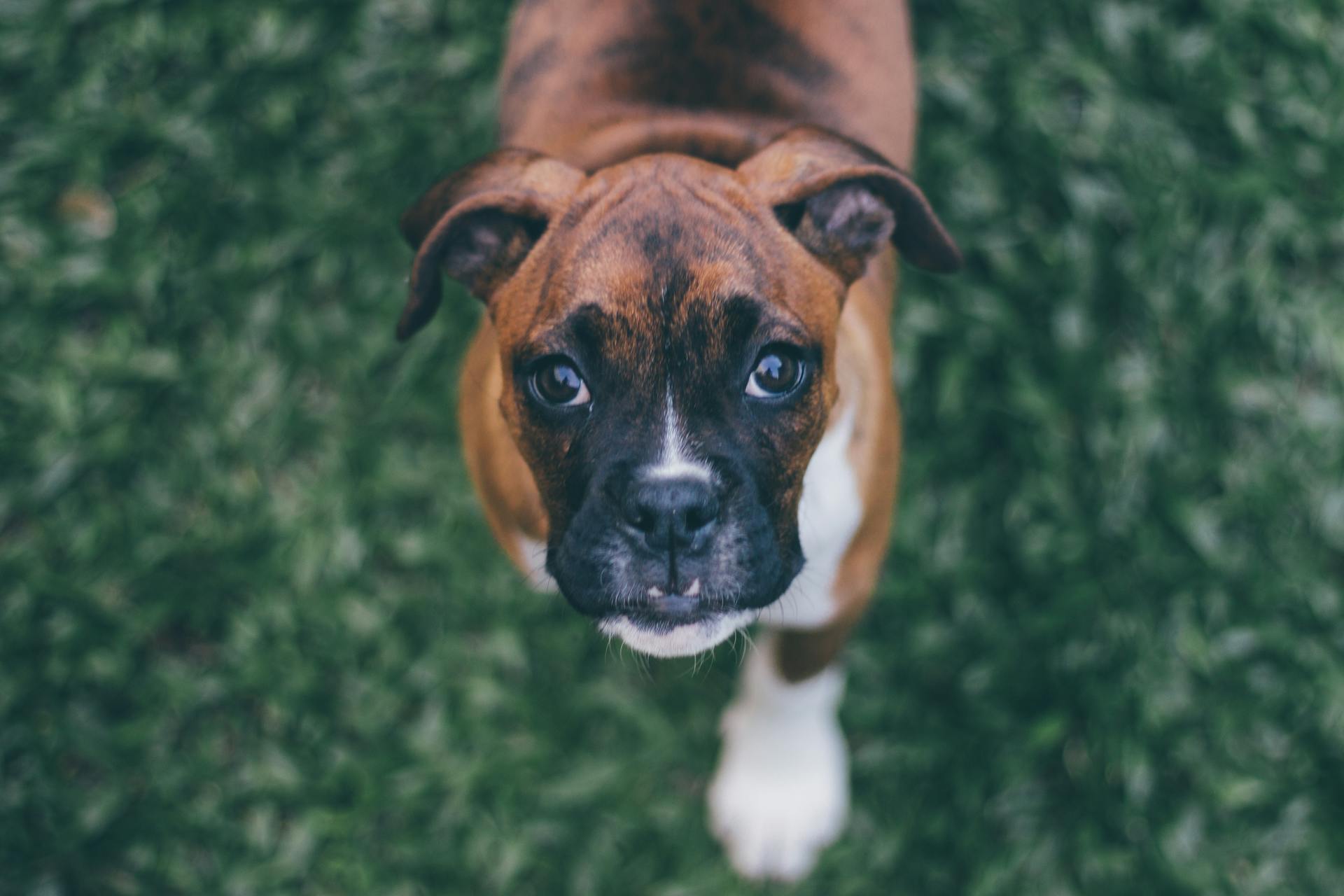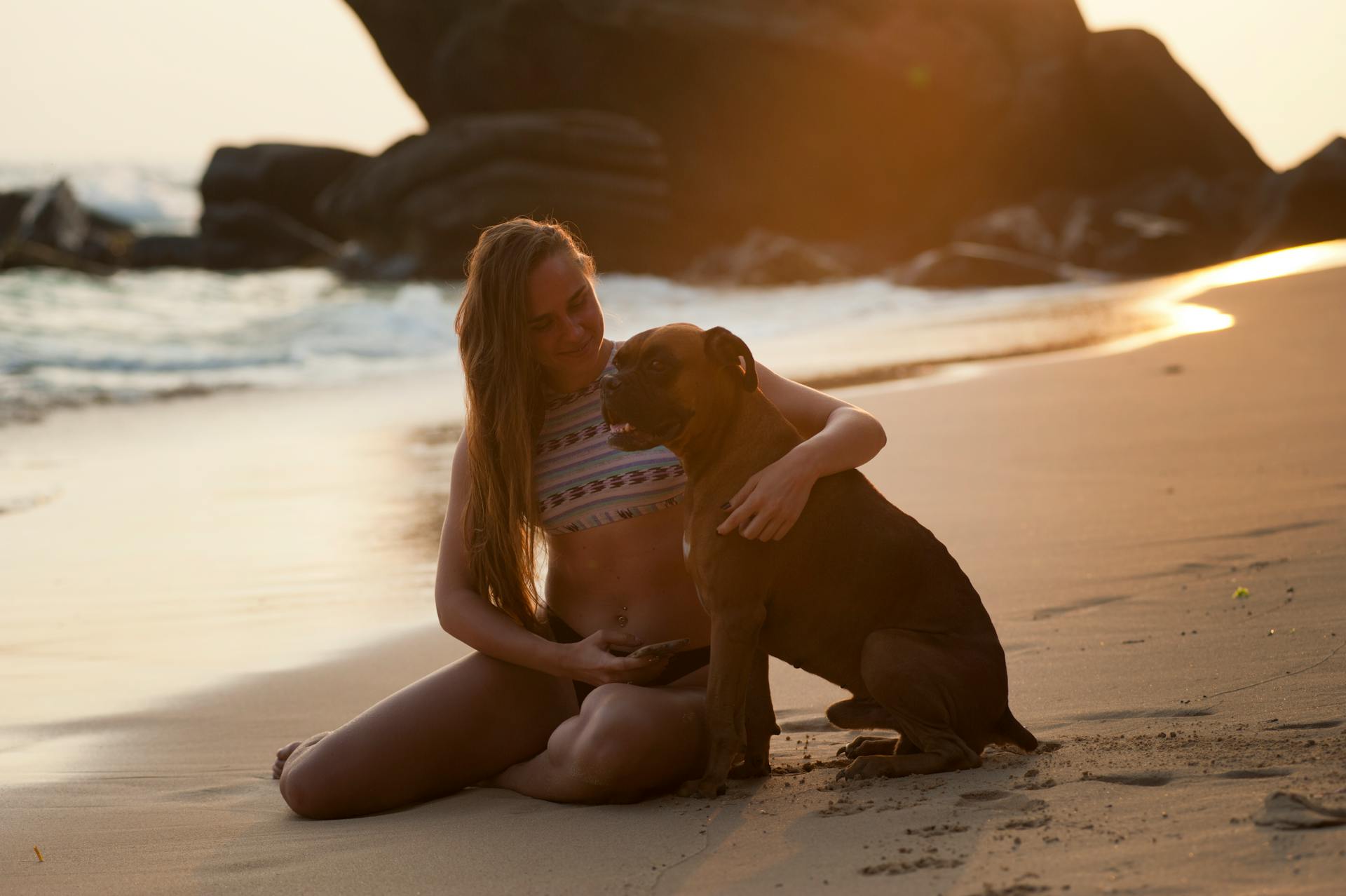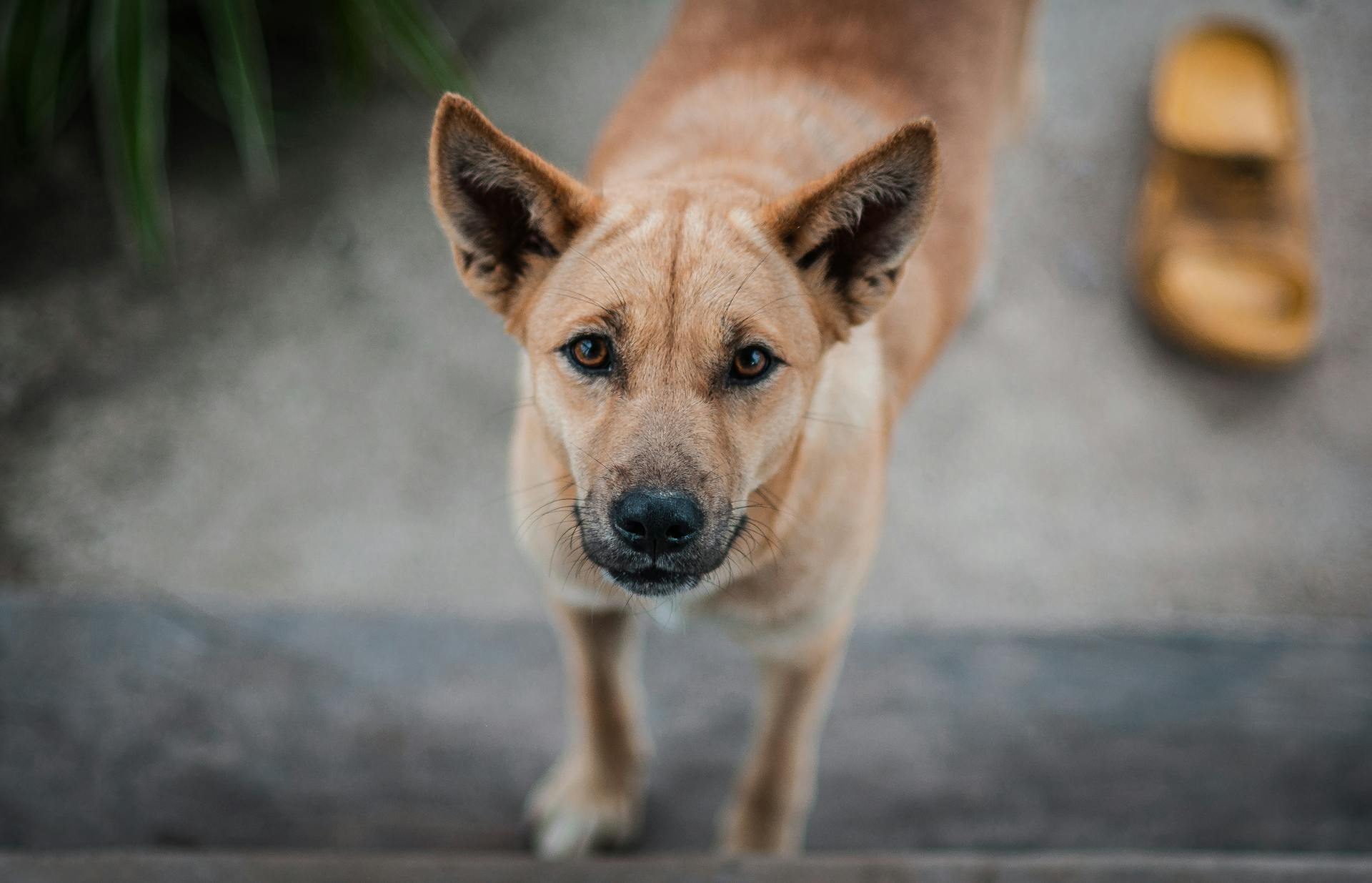
The Boxer is a playful and energetic breed that originated in Germany in the late 19th century.
They were first bred as a working dog to guard and escort horse-drawn carriages.
Boxers are known for their distinctive "boxer" face, with a short, compact muzzle and a prominent underbite.
Their short coats require minimal grooming, making them a great choice for busy owners.
Expand your knowledge: Short Bulldog Breeds
Physical Characteristics
Boxers are a medium to large breed of dog, and their physical appearance is quite distinctive. They have a short and flat coat that comes in three main colors: fawn, brindle, and white.
A Boxer's head is its most distinctive feature, and it must be in perfect proportion to the body. The muzzle is short and should be angled slightly backwards, with a black nose.
The jaw of a Boxer has an underbite, meaning the lower jaw protrudes beyond the upper jaw and bends slightly upwards. This is a common characteristic of the breed.
Boxers have a muscular build, which gives them an imposing appearance. They are a sturdy breed, but they are also agile and athletic.
Here are some key physical characteristics to look for in a purebred Boxer:
- Square-shaped head
- Short muzzle with black nose that is angled slightly backwards
- Jaw with an underbite
- Muscular build with an overall imposing appearance
Personality and Temperament
Boxers are known for their happy, playful personalities and high energy levels. They make great family pets, especially for families with children.
Boxers are generally very good with kids, patient and spirited, but also protective. This makes them a popular choice for families.
Boxers are not naturally aggressive or vicious, but they can become attached to their family and make instinctive guardians. Proper socialization is essential to ensure they get along with other pets.
Boxers are highly trainable, but they respond best to positive reinforcement techniques like clicker training. This approach allows them to think independently and problem-solve.
Boxers are intelligent dogs, ranking number 48 in Stanley Coren's survey of obedience trainers. However, many experienced trainers disagree with this ranking, finding that Boxers have above-average intelligence and working ability.
Boxers are generally comfortable with companionship, whether human or canine, and are great with people of all kinds. They are also low maintenance in terms of grooming, requiring only a brushing every few weeks.
Here are some key characteristics of the American Boxer breed:
- Active
- Protective
- Very trainable
- Courageous
- Muscular
- Athletic
- Intelligent
- Fun
- Good with kids
- Friendly
- Playful
Boxers were originally bred as guard dogs, and they still make excellent guard dogs today. They are also used as police dogs, war canines, cattle herders/protectors, watchdogs, and protection dogs.
Health and Nutrition
Boxers are prone to various health issues, including cancers, heart conditions, and degenerative myelopathy. They also have a relatively short lifespan, with a median of 10.25 years.
Boxers are one of the more commonly affected breeds for degenerative myelopathy, and their kidneys are also at risk due to Boxer Juvenile Kidney Disease (JKD). JKD is an inherited condition that affects the kidneys' development during gestation, leading to chronic renal failure.
To minimize the occurrence of these diseases, responsible breeders use available tests to screen their breeding stock before breeding. This helps to reduce the risk of passing on inherited conditions to future generations.
A UK Kennel Club health survey found that cancer accounts for 38.5% of Boxer deaths, followed by old age, cardiac, and gastrointestinal related issues. This highlights the importance of regular health checks and monitoring for any signs of illness.
Here's a rough breakdown of the common health issues affecting Boxers:
- Cancers (38.5%)
- Old age (21.5%)
- Cardiac issues (6.9%)
- Gastrointestinal issues (6.9%)
Boxers also require a high-quality diet that's rich in lean animal protein and omega-3 fatty acids to support their skin, coat, and joint health.
Health Issues
Boxers are prone to several health issues, so it's essential to be aware of them and take preventative measures. Cancer accounts for 38.5% of Boxer deaths, followed by old age, cardiac, and gastrointestinal related issues.
The breed is particularly predisposed to mast cell tumours, a cancer of the immune system. Responsible breeders use available tests to screen their breeding stock before breeding, and in some cases throughout the life of the dog, to minimize the occurrence of these diseases in future generations.

About 22% of puppies die before reaching seven weeks of age, mostly due to stillbirth or infection. Mortality due to infection increases significantly with increases in inbreeding.
Boxers have a relatively short lifespan, with a median lifespan of 10.25 years. The typical Boxer lifespan is 10–12 years, but some studies have found a life expectancy of only 9 years for the breed.
They are also prone to heart conditions, including aortic stenosis and arrhythmogenic right ventricular cardiomyopathy, also known as "Boxer cardiomyopathy".
Consider reading: How Long Do Boxer Dogs Usually Live
Nutrition
Boxers need a high-quality diet to support their exercise needs, so lean animal protein like chicken, turkey, lamb, and fish should be the main source of calories. This can help prevent obesity, which is a common issue in Boxers.
Treats should be given sparingly, as they can contribute to weight gain. A good rule of thumb is to balance the food-to-snack ratio to determine how many treats are acceptable.

Boxers are prone to dental problems, which can lead to bad breath and other issues. Feeding dry dog food that is large and difficult to chew can help remove plaque, while kibble with crude fiber can also help with plaque removal.
Some healthy snack options for Boxers include raw fruits and vegetables.
Here are some key factors to consider when choosing a dog food for your Boxer:
Feeding your Boxer two meals per day, about every 12 hours, can be beneficial for their overall health. Using slow feeder bowls can also help prevent bloat and GDV.
Boxer puppies, on the other hand, need to eat more frequent meals, about three or four times a day. Maintaining a healthy weight is crucial for protecting a Boxer's joints, so it's essential to monitor their caloric intake and adjust their diet accordingly.
Pet Care Considerations
Regular health check-ups are essential for Boxers, including tests for thyroid deficiency, heart ailments, cancers, and hip evaluation. These tests will help ensure your Boxer stays in good shape.
Boxers have a very low requirement for grooming, thanks to their short coat. A soft brush is all you need to clean their coat once a week.
Boxers are extremely active and playful dogs and need constant physical activity. They require 30 minutes to two hours of exercise every day.
A high-calorie diet is necessary for Boxers, with a high amount of protein in their dog food. However, be careful not to overfeed your pet, as this can lead to physical ailments and heart diseases.
Some common colors of Boxers include brindle, fawn, and white, with white and black markings.
Here's an interesting read: White Boxer Dogs
Training and Behavior
Boxers are highly intelligent and trainable, but they often require patience due to their high energy level. They will learn if given clear and consistent guidance through positive reinforcement training.
Early leash training is crucial to stop your dog from pulling on the leash while walking, which is common in Boxers. Supervision is also important when your pup is outside to prevent digging and tunneling under a fence.
Boxers are sensitive dogs and may not respond well to harsh training or scolding, so it's essential to use positive training methods like reward-based training. You can use a pack of their dog treats as rewards to encourage good behavior.
Behavior and Training
Boxers have a strong prey drive and can be tempted to chase after birds and small mammals, so it's essential to keep them on a leash or in a fenced-in space.
Early leash training can help prevent your Boxer from pulling on the leash while walking, a common issue with this breed.
Boxers are highly intelligent and trainable, but they require patience due to their high energy level.
Positive reinforcement training is key, as Boxers respond well to clear and consistent guidance.
Socializing Boxer puppies at an early age is crucial for their development into confident and polite dogs.
Boxers are extremely sensitive and may not respond well to harsh training or scolding, so it's best to use reward-based training methods.
You can use a pack of their favorite dog treats as rewards to encourage good behavior.
Boxers enjoy digging in the yard and may even tunnel under a fence, so supervision is necessary when they're outside.
Getting Started in Sports

Getting started in dog sports is an exciting venture, and there are several ways to begin. You can start by learning about the different types of dog sports available.
The American Kennel Club (AKC) offers a variety of dog sports, including agility, obedience, and tracking. You can search for AKC clubs in your area to find a training group that suits you and your dog.
To get started, it's essential to understand the basics of dog sports. The AKC provides an introduction to dog sports, which covers the fundamentals of each sport. You can also learn about canine partners and how to enroll your mixed-breed dog in a dog sport.
If you're new to dog sports, it's crucial to know the titles and abbreviations used in the different sports. This will help you understand the rules and regulations of each sport.
Before choosing a dog sport, consider your dog's breed, age, and ability. The AKC suggests looking at the different sports and finding one that suits your dog's needs.

To get started with dog training, you can follow the AKC's guidelines on getting started in dog training. This will help you understand the basics of dog training and how to progress to more advanced training.
You can also participate in virtual dog sports and events, which can be a great way to get started or supplement your in-person training.
Here's a list of resources to help you get started:
- Search for AKC clubs in your area to find a training group that suits you and your dog.
- Find an event in your area to participate in dog sports.
Breed History and Heritage
The Boxer breed has a rich history that dates back to the late 19th century. It originated from the Bullenbeisser, a dog of English Mastiff descent, and Bulldogs brought in from Great Britain.
The Bullenbeisser was a hunting dog that had been working for centuries, employed in the pursuit of bear, wild boar, and deer. Its task was to seize the prey and hold it until the hunters arrived.
In the late 19th century, the breed was further developed in Germany, and a smaller Bullenbeisser was bred in Brabant, in northern Belgium. This smaller Bullenbeisser is generally accepted as being a direct ancestor of today's Boxer.
The first Boxer Club was founded in 1895 by three Germans, Friedrich Robert, Elard König, and R. Höpner. They published the first Boxer breed standard in 1904, which has not been changed much since.
The breed was introduced to other parts of Europe in the late 19th century and to the United States around the turn of the 20th century. The American Kennel Club (AKC) registered the first Boxer in 1904.
The Boxer played a significant role in World War I, acting as a valuable messenger dog, pack carrier, attack dog, and guard dog. This experience helped establish the breed as a reliable and versatile companion.
Meta von der Passage, a predominantly white female Boxer, is considered the mother of the breed. She was a substantially built, low-to-the-ground, brindle and white particolor, and her offspring dominated all present-day pedigrees.
The first American Boxer to win the Westminster Dog Show was Bang Away, who won in the 1950s and became famous.
A different take: Breeds of Small White Fluffy Dogs
Colors and Patterns
The Boxer's coat is a key part of its charm, and it's worth getting to know the different colors and patterns that make each dog unique.
The Boxer's coat is short-haired and smooth, lying tight to the body.
Fawn and brindle are the recognized colors, with fawn being a range of colors including light tan, yellow, reddish tan, mahogany, and stag/deer red.
In the UK and Europe, fawn Boxers are typically rich in color and are often called "red".
Brindle refers to a dog with black stripes on a fawn background, and some brindle Boxers are so heavily striped that they give the appearance of "reverse brindling".
The breed standards state that the fawn background must clearly contrast with or show through the brindling.
Here are the different types of brindle:
- Tiger brindle
- Mahogany brindle
- Reverse brindle
The Boxer does not carry the gene for a solid black coat color, so purebred black Boxers do not exist.
Reverse brindle Boxers have a light-colored background with dark stripes, giving the appearance of a solid dark coat.
Expand your knowledge: Black Boxer Dog Breed
Frequently Asked Questions
How much is a purebred Boxer worth?
A purebred Boxer's value ranges from $800 to $2,500 from a reputable breeder. Adoption fees may also apply, varying depending on the circumstances.
How much does a pure bred Boxer weigh?
A purebred Boxer typically weighs between 55 to 80 pounds, depending on its sex and size.
Featured Images: pexels.com

